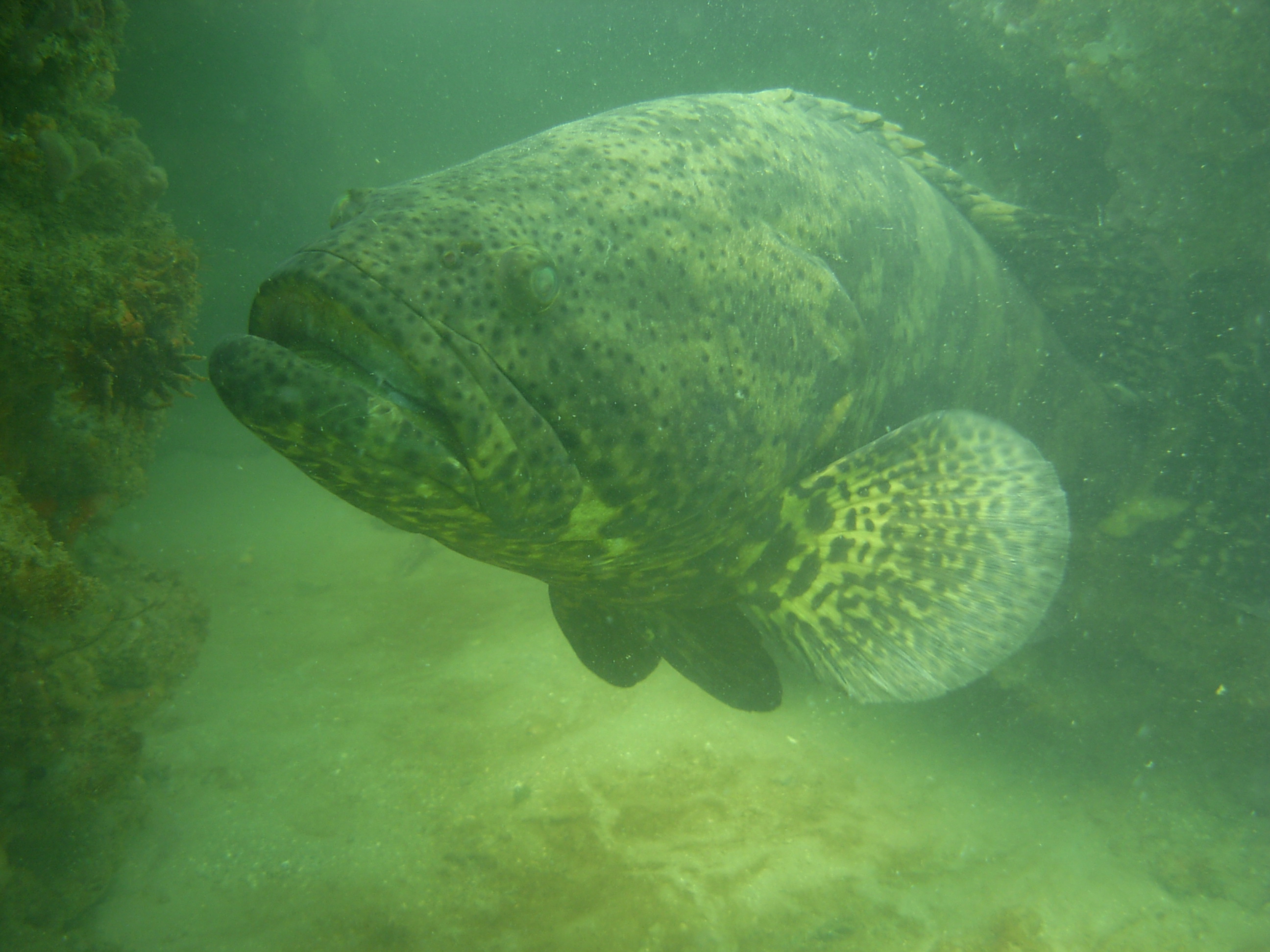
by Rick O'Connor | Jun 3, 2016
For several years now Dr. Angela Collins, with Florida Sea Grant, has been conducting research on the status of the Goliath Grouper. This extremely large member of the Family Serranidae has been of concern to fishermen, divers, and resource managers in south Florida. The harvest of goliath groupers has been prohibited since 1990 but their populations have certainly increased. Once found throughout the Gulf region, they became rare from recreational and commercial harvesting in the 1970’s and 80’s; most of the fish that were encountered were encountered in southwest Florida. Today, their numbers have increased and records of the animal have been logged from Tampa Bay, the Big Bend, and now from the Panhandle region. At this point FWC is not sure whether the numbers have recovered enough to remove the ban from harvesting.
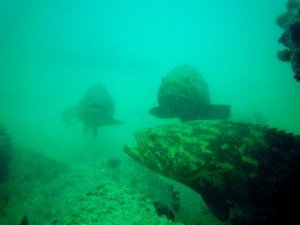
Three goliath groupers over wreck in southwest Florida. Photo: Bryan Fluech Florida Sea Grant
Each year, during the first week of June, Dr. Collins conducts a statewide survey of Goliath Grouper encounters. She is particularly interested in Goliath Grouper sightings in the panhandle. This year the survey will begin this Sunday – June 5 and extend to Saturday June 11. Any diver interested in participating in the survey should contact their local Sea Grant Agent to obtain the official data sheet. These sheets can be scanned and returned to your local Sea Grant Agent – or you can contact them for alternative methods for submitting the results.
We hope local divers will consider helping us with this needed information. These data sheets will be part of the annual assessment of the status of this neat fish. For more information visit the Florida Sea Grant website (https://www.flseagrant.org/news/2016/06/great-goliath-grouper-county-provides-fisheries-managers-stock-assessment-data/).
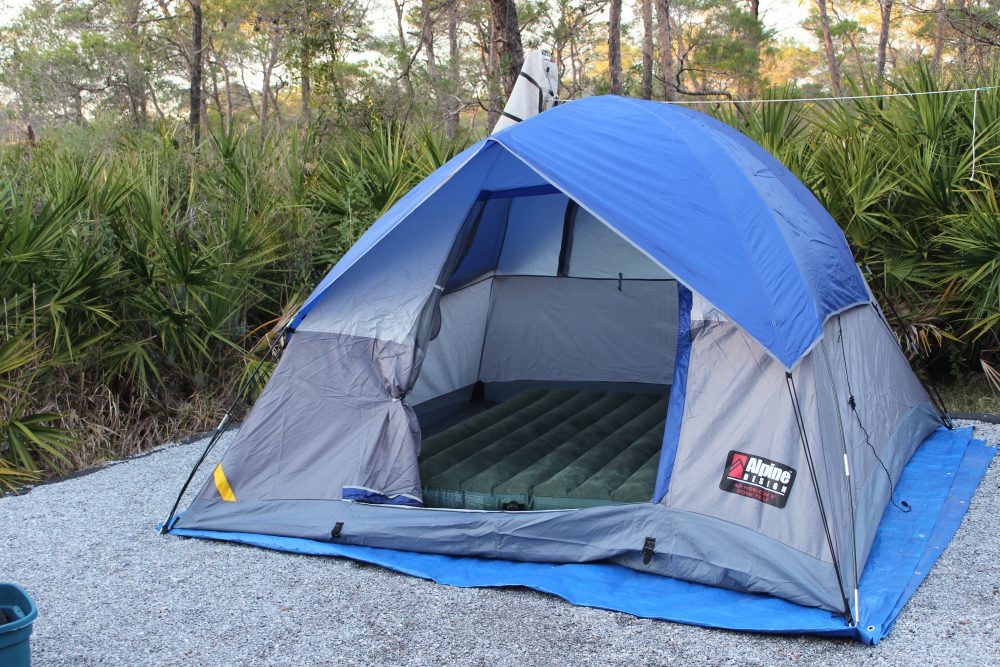
by Rick O'Connor | May 22, 2016
ALL PHOTOS: MOLLY O’CONNOR
Continuing our “ecotour” of the Florida Panhandle along the ICW, this month’s stop is in Walton County. Arguably one of the fastest growing counties in the state, South Walton has become a favorite with many. Relatively undeveloped (as compared to neighboring counties) Walton has an opportunity to develop smarter… and for a lot of it – they have.
Entering Walton County from the west you leave the concentrated tourism of Destin and enter Sandestin. Though still highly developed it slowly gives way to the Point Washington area and more open ground. Here you begin to encounter the famous Dune Lakes. There are no barrier islands along the coastline of Walton County. Instead the Gulf meets the peninsula separating it from Choctawhatchee Bay to the north. Along the Gulf there are magnificent dune fields and freshwater lakes that periodically are open to the Gulf. The lakes are unique in that they have freshwater habitats and tannic waters as well as saltmarsh and seawater when their “mouths” are open. This unique situation provides an ecosystem found in few places in our state. The now famous 30-A travels along these dune lakes across the entire of South Walton. Two state parks, a state forest, a bike trail, and small communities dot this famous trail.
Between 30-A and the Intracoastal Waterway to the north lies the Point Washington State Forest. Here lie acres of well managed pine forest. There are many trails that can be hiked, driven, or traversed by horseback. There are several trails here that are part of state forest’s Trailwalker Program. A major part of this well managed forest is prescribed burning.
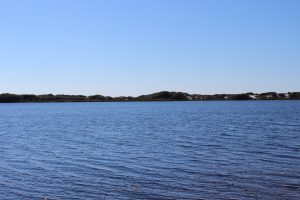
This dune lake at Topsail State Park is one of many “stretched” across South Walton County.

The state park provides kayaks for exploring the dune lake at Topsail. It can be reached by hiking or a tram they provide.
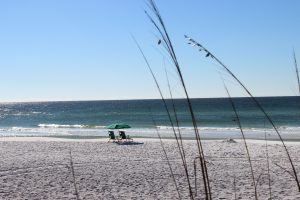
The beautiful beaches of south Walton.
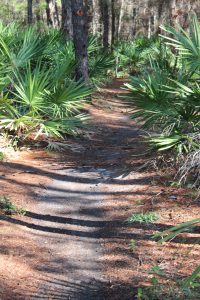
Here is one of the many state forest trails used by hikers and joggers.
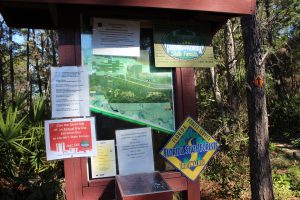
The Florida State Forest hiking trail system provides a lot of information about their trails that is very useful.

The Florida State Trailwalkers Program is a neat way to encourage locals to visit their “natural landscape”. You must hike 10 of the selected trails (on their website provided in this article). There is a log you can download and when you have logged your 10 hikes mail it in. You will receive a free patch indicating you are a “Florida Trailwalker”! This is a great way to explore your “natural Florida”.
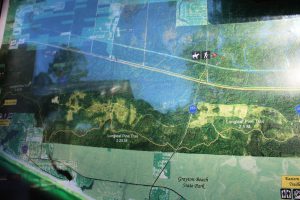
There are trails that cross Point Washington State Forest that can be driven, hiked, or even explored on horseback.
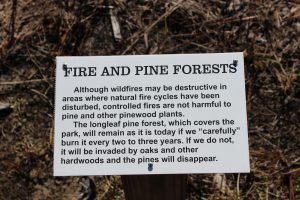
Signage educating the public about the benefits of prescribed burning.
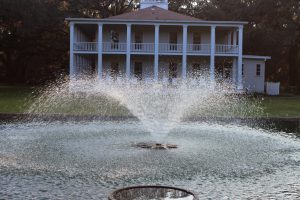
This is the renovated Wesley House at Eden Gardens State Park. The Wesley’s were in the timber industry.
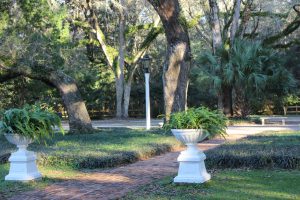
Eden Garden State Park is located north of Highway 98 in south Walton County. It borders the south side of the ICW near Choctawhatchee Bay and is a beautiful getaway.
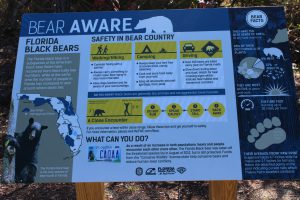
Partly due to successful bear management and partly due to the increase population of humans in the Florida panhandle, bear encounters are in the increase. This sign at Eden Garden State Park provides information on how to deal with an encounter.
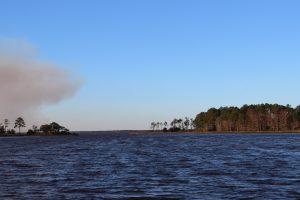
From Eden Garden State Park you can look across the bayou to the point where the ICW leaves Choctawhatchee Bay and enters a manmade canal locals refer to as “the ditch”. Notice the prescribed burn occurring across the bay.
PRESCRIBED BURNING
Now days many are aware of the forest management tool we call “prescribed burning”… but not all. For many people, fires are “wild” and the smoke they generate is an unwanted pain. Much of the southeast, particularly Florida, encounter thunderstorms with frequent lighting. These lighting strikes spark fires which burn across acres of forest. The frequency of the lighting storms – and fires – actually kept the understory below the pines cleared and so the fires typically burned low and slow. The result was an understory of grasses and wildflowers that supported a wide variety of species including deer and quail. When he traveled through the southeast in 1775, William Bartram described the longleaf forest as “open and monotonous – going on for miles”. And this was the case… you could literally see up to a mile across the landscape. But this “monotonous” landscape was misleading in that there were thousands of species found here – many feel one of the most biological diverse systems anywhere.
Today 90% of the longleaf has been logged and much of what remains is fire suppressed. For the reasons mentioned above, residents have resisted the natural burns and many species – gopher tortoises, quail, and indigo snakes to name three – have suffered as well. There is a move across the southeast to restore the old longleaf pine forest. These trees produce excellent timber – though it takes longer to grow than the loblolly and slash pine currently grown – and many are managing their property for quail and deer hunting. Yes… the smoke is a problem but the state forestry system plans their burns to reduce the impact it has on the local community as best they can. If you really want to see the benefits of a well-managed pine forest, take a hike through one – it truly is amazing.
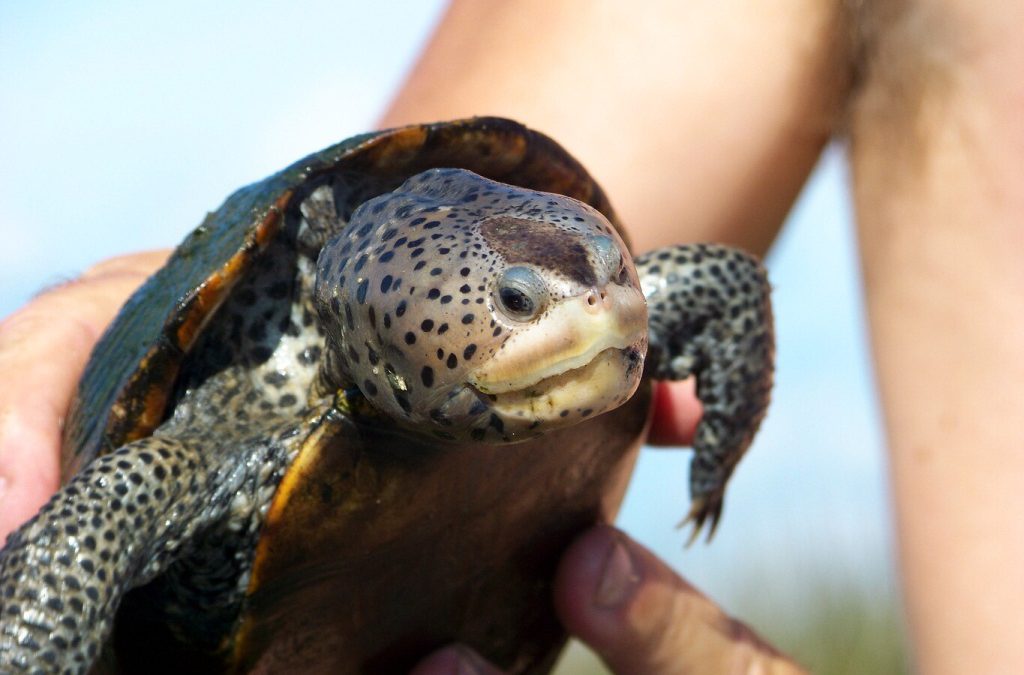
by Rick O'Connor | May 8, 2016
When doing programs about snakes I find plenty of people who hate them… but I have never found anyone who hated turtles. I mean what is there to hate? They are slower, none of them are venomous, they have shoulders… people just like them. And to that point, when people see them crossing the road almost everyone wants to help. But that can be dangerous – for you and for the turtle. Here are couple of safety tips you should know before helping a turtle cross the road.

This small turtle can be held safely by grabbing it near the bridge area on each side.
Photo: Molly O’Connor
Your Safety
You would be surprised by the number of people, particularly children, that are hit by cars while trying to help turtles cross the road. One story I heard involved nine-year-old girl who was riding in the backseat with her grandmother. They both saw the turtle trying to cross a busy highway and wanted to help. The grandmother pulled over to the side but before she could even get the car in park the little girl opened the door and ran into the highway only to be struck by an oncoming car. We all like turtles, and do not want to see them hit by cars, but as sad as it is to see a turtle hit – it is horrific to see the same happen to a child. No matter what your age – please watch for traffic before attempting to help a turtle.
Turtles Bite
Yep… unlike their reptilian cousins the snakes, lizards, and alligator, turtles do not have teeth… but they do have a beak. The beak is made of a hard bony like material that is blade sharp in carnivorous turtles, and serrated like a saw in herbivorous ones – both can do serious damage. Some species of turtles feed on a variety of shellfish, and if they can crush shell they can certainly do a number on your hand – so you have to be careful. First thing you should do is determine whether the turtle needs to be handled. If traffic is not too bad, or the road not too wide, you may be able to just manage traffic so the turtle can cross on its own. If you feel that you must handle the turtle, there are safe ways to hold them. Smaller turtles can be held safely from the sides by grabbing the bridge area – the portion of the shell connecting the top (carapace) to the bottom (plastron). Many turtles will begin to kick their feet when you do this and their claws may scratch – be prepared for this. There are two groups of turtles that have extended necks and your hands, grasped near the bridge of their shell, are still within range of their mouths – these are the snapping and softshell turtles. Both are notorious for their bites. So how do you handle those? Below is a short video put together by the Toronto Zoo that gives you some ideas on how to handle those situations.
https://m.youtube.com/watch?v=Lgd_B6iKPxU
Turtle Direction
Turtles cross highways for a variety of reasons – females looking for high dry ground to nest, individuals looking for more productive ponds, males looking for females – whatever the reason they are heading that way and will continue to do so. Placing them on the side of the highway where they came from will only initiate another attempt to cross. Move them to the side of the road they were heading.
The majority of turtle crossings occur during spring and summer. Untold numbers are killed each year on our highways – many gravid females carrying the next generation of the species. Though we encourage turtle conservation in Florida you do have to be smart about it. If you have any questions about Panhandle turtles in Florida contact your local extension office.

by Rick O'Connor | Apr 22, 2016
ALL PHOTOS: MOLLY O’CONNOR
As many of you already know each month we have posted articles about nature tourism locations along the Intracoastal Waterway in the Florida Panhandle. This month we visit coastal Okaloosa County.
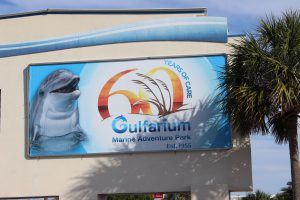
The Gulfarium in Ft. Walton Beach gives those who do not get a chance to go offshore, or dive, to see some of the unique marine organisms found in the Gulf of Mexico.
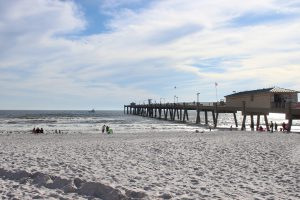
As with many other fishing piers along the panhandle, the Okaloosa Pier not only provides a spot for good fishing but a good spot to watch for marine life and great sunsets.
For years’ tourists have been visiting the beaches of Ft. Walton and Destin. The big draw has been the clean white sand but the area is also known for its really clear water. This clear water has supported a charter fleet that focuses on diving and fishing, but in recent years several operations have included inshore snorkeling and even trawling for marine life for tourists to view.
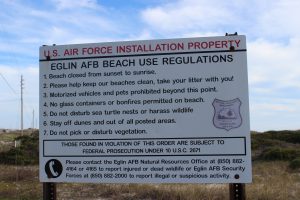
Many feel that you are not allowed on Eglin property. This is true for much of the island under their jurisdiction but there are places where you can park and enjoy the beach – though you must obey their rules.
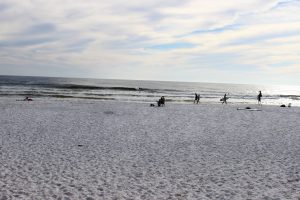
Residents enjoying the beach at one of the public access points on Eglin property.

Destin harbor is now home the Haborwalk. There is a lot to see and do on the Haborwalk – and plenty of boat tours.
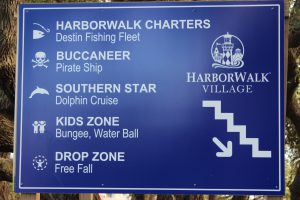
This sign gives the visitor some idea of the different activities that can be found along the Haborwalk.
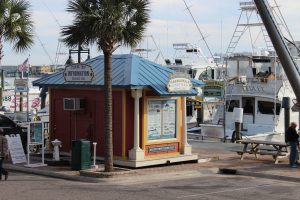
There are numerous types of tours to found along the Harborwalk. Information booths such as this one can help you find what you are looking for.
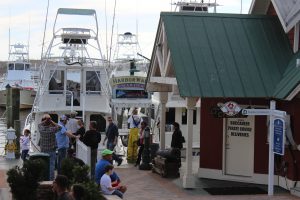
Charters include fishing, diving, snorkeling, and some collect marine life for you to see.
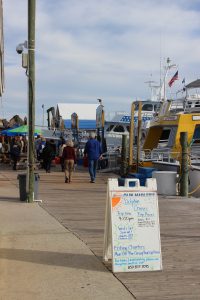
Dolphin cruises are very popular.
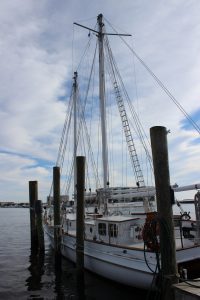
There are sailing charters that will allow you to experience the Gulf of Mexico, sunset cruises, and there are some designed with kids in mind.
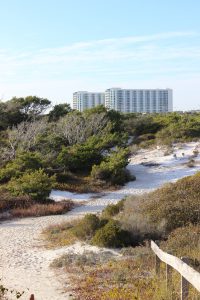
Henderson State Park is on the south side of Highway 98. It has hiking trails, a campground, and access to the Gulf. This is a nice natural location within a very urban area.
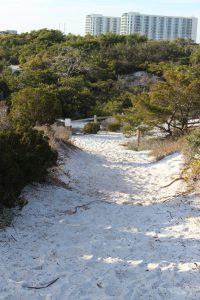
One of the scenic trails where you can explore the natural dune ecosystem in Henderson State Park
ARTIFICIAL REEFS
The natural substrate for most of the northern Gulf of Mexico is quartz sand. There are areas of hard bottom, shell hash, and even some natural reefs but sand dominates the landscape beneath the waves. There is no question that the natural coral reefs of the Florida Keys have been a huge economic engine for that part of the state. The clear, high saline water is filtered by the Everglades and allows much needed light to reach the tiny coral polyps and their symbiotic plant partners, which in turn produce limestone substrate for the polyp colonies to live and grow on.
Locally we have rivers that discharge into the Gulf but the water clarity is still pretty good. The bigger problem for coral development here is the cold winter temperatures and the lack of hard substrate for coral colonies to attach. There are several species of corals, and other encrusting invertebrates and plants, that can tolerate our cooler winters but substrate is still an issue. The answer… artificial substrate… artificial reefs.
Northwest Florida and Alabama have one of the most active artificial reef programs anywhere. Thousands of structures from small concrete pyramids, to chicken coops, to U.S. Navy vessels have been dropped to the bottom. The concept is “build it… and they will come” – meaning the encrusting organisms and eventually larger predatory fishes. At first artificial reefs were just left over rubble and car bodies that were indiscriminately dropped on the Gulf floor. But over years’ marine scientists began to monitor and evaluate what works and what does not and artificial reefs became a science. One question has not been answered… do artificial reefs generate more fish for fishermen – or do they just congregate the existing number of fish into more easily accessible points in the Gulf for easy capture? There is science that supports both arguments… and the debate continues. But if you want to know whether artificial reefs have been an economic success the answer is… yes… by the tens of millions of dollars it has. The charter fleets of Ft. Walton, Destin, Panama City, and Pensacola have all benefited from the artificial reef program. There are numerous structures to dive and many are part of the Florida Panhandle Shipwreck Trail.
If you get a chance take a charter and dive, or fish, one of these interesting and well thought out habitats. Next month we head further east to Walton County and the famous “30A” highway.
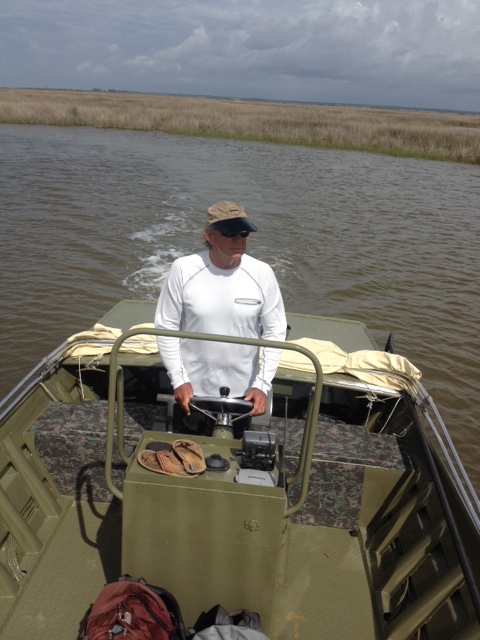
by Rick O'Connor | Apr 22, 2016
Many folks are putting together a “bucket list” of things they would like to do or see before they can no longer do them. For many interested in natural resources there are certain national parks and scenic places they would like to visit. Other natural resource fans have a list of wildlife species they would like to see.
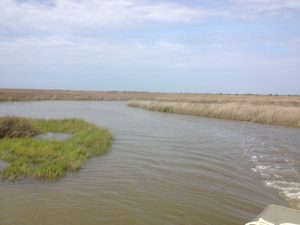
Terrapins inhabit creeks, such as this one, within the expanse of the salt marsh. Here you can see their heads pop up above the water and you may get lucky enough to find one basking.
Photo: Rick O’Connor
Recently I hooked with famed Alabama outdoorsman Jimbo Meador to search for locations to find Alabama turtles. Jimbo has been fishing, hunting, and enjoying the Mobile Bay area all of his life and he now using that knowledge as a guide in a nature-based tourism project. He recently received a call from a group of gentleman from another part of the country who had on their bucket list viewing 1000 reptilian species in their native habitat. In Alabama they were interested in the Black-knobbed Map Turtle, the Alabama Red Belly, and the Diamondback Terrapin. Jimbo has just begun the first module of the Florida Master Naturalist Program and reached out to us for advice on where to find these guys. Luckily, after working with scientists from the University of Alabama at Birmingham, I knew where to find diamondback terrapins – and have a pretty good idea on the others.
These “diamonds of the marsh” – as they are sometimes called – are very elusive creatures. They inhabit muddy bottom creeks within extensive salt marsh habitat all along the Gulf and East coast of the United States. I spent two years searching the Florida panhandle before I found my first live animal. It was one of the odd things though – once you have seen one, you now know what you are looking for and begin to find more.
I took Jimbo to a location near Dauphin Island where about 150 terrapins are believed to exist. Terrapins spend most of their day within creeks that meander through acres of salt marsh. The odd thing is there may be hundreds of creeks within these marshes and the terrapins – for some reason – will select their favorites and hang there. You can spend all day paddling through perfect looking creeks not seeing a head at all… then all of sudden… you enter one creek… not really any different than the others… and there they are.
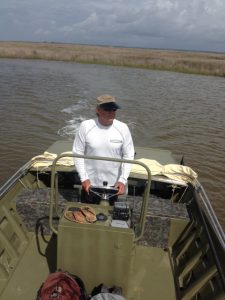
Veteran waterman and outdoor guide, Jimbo Meador, explores the marshes near Dauphin Island for the elusive diamondback terrapin.
Photo: Rick O’Connor
Within these creeks they feed on a variety of shellfish but particularly like the marsh periwinkles. These small snails are the ones that climb the cordgrass and needlerush plants during high tide to avoid their nemesis the blue crab and the diamondback terrapin. Terrapins do crawl out of the water to bask in the sun and have been known to bury in the loose fine mud. Females must find high dry ground to lay her eggs. She may swim as far as 5 miles from her home creek to find a suitable beach. They do like sandy beaches that are open and free of most plants. They emerge onto these beaches during May and June to lay about 7-10 eggs. Most females will lay more than one clutch each season emerging once every 16 days or so. Different from sea turtles – terrapins nest during the daylight hours. Actually the sunnier – the better. Raccoons are a big problem… find and consuming the eggs; on some beaches researchers have reported 90% or more of the nest have been raided by the furry guys. Crows, snakes, and possibly armadillos will take nests as well. If the developing young survive the 60+ days of incubation, they will emerge and head for the grass areas of the marsh… not the water. Here they will spend the first year of their life living more like a land turtle before they make their way to the brackish waters of the salt marsh.

Open sandy beaches, such as the one in this photograph, are the spots females terrapins seek when they are ready to dig a nest.
Photo: Rick O’Connor
These are fascinating creatures and should be on everyone’s natural resource bucket list. The hard effort of finding them really makes doing so very rewarding. On this day Jimbo saw only one head – I did not see any. I have found in my study site that I see more heads in the afternoon (we were out in the morning). I do not know if this is the case at all terrapin nesting sites, but something to consider when looking. Though we did not find many that day he now knows what to look for when searching for them. Next we will have to hunt the Alabama Red Belly Turtle. That is another story for another day.
We will continue this series with other interesting wildlife creatures to “hunt” in the Florida panhandle.


































